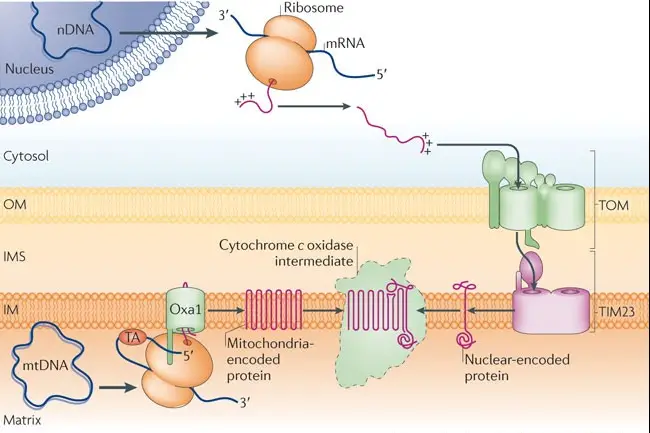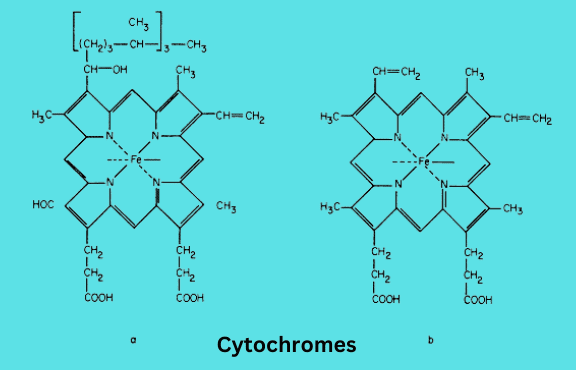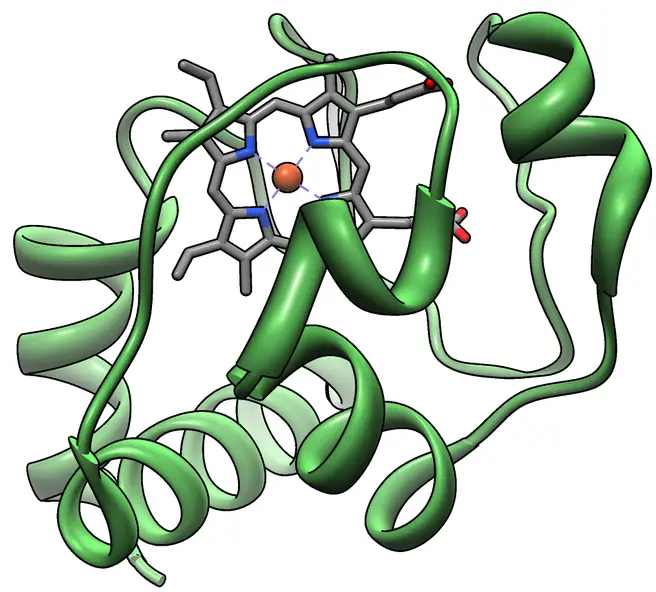Cytochromes are a group of heme-containing enzymes pivotal to the electron transport chain, a critical component of cellular respiration. These proteins exist in various forms, each playing a unique role within the bioenergetic processes of living cells. Among them, Cytochrome C stands out due to its widespread study and essential functions in higher organisms. This introduction aims to shed light on how Cytochrome C differentiates from its counterparts.
Cytochrome C and other cytochromes differ primarily in their structure, function, and location within the cell. Cytochrome C is known for its role in the electron transport chain, acting as a mobile electron carrier between different enzymes. Unlike other cytochromes, which might be membrane-bound and have varying roles, Cytochrome C is consistently involved in initiating apoptosis, highlighting its crucial role in cellular health and lifecycle regulation.
The structural differences between Cytochrome C and its cytochrome peers, such as Cytochrome A and B, extend to the arrangement of their heme groups and the pathways they influence. These variations not only impact their specific functions but also their mechanisms of action within cellular respiration and beyond. Understanding these differences is essential for grasping their biological significance and potential impacts on health and disease.

Cytochrome Basics
Definition of Cytochromes
Cytochromes are a diverse group of proteins classified as heme proteins due to the presence of a heme group, an iron-containing compound that plays a crucial role in electron transport within cells. These proteins are involved in redox reactions across various biological systems, essentially acting as catalysts in electron transfer processes crucial for cellular respiration and energy production.
Role in Cellular Respiration
The primary role of cytochromes in cellular respiration is to facilitate the transfer of electrons through the electron transport chain (ETC). Located within the mitochondria, the ETC is a series of complexes that undergo redox reactions, moving electrons from donors to acceptors via cytochromes, generating a proton gradient used to produce adenosine triphosphate (ATP), the cell’s energy currency.
- Electron Acceptance and Donation: Cytochromes accept an electron from one molecule and donate it to another, functioning as middlemen in electron transport.
- Energy Production: As electrons move through cytochromes from higher to lower energy states, the energy released is used to pump protons across the mitochondrial membrane, facilitating ATP synthesis.
Common Types
There are several types of cytochromes, each classified based on the structure of their heme group and the specific role they play in the electron transport chain:
- Cytochrome c: Soluble protein found in the intermembrane space of mitochondria.
- Cytochrome b: Part of Complex III of the ETC, integral to the mitochondrial membrane.
- Cytochrome a: Includes cytochrome a and a3, forming part of Complex IV of the ETC.
Cytochrome C Overview
Structure Specifics
Cytochrome C is characterized by its small size and high solubility, distinguished by a single heme group attached via a thioether bond to the protein backbone. The structure allows for rapid movement, facilitating efficient electron transfer between complexes III and IV of the electron transport chain.
Function and Mechanism
The primary function of Cytochrome C is to carry electrons between Complex III (cytochrome bc1 complex) and Complex IV (cytochrome c oxidase) in the mitochondria. This role is critical for the generation of ATP through oxidative phosphorylation.
- Electron Carrier: Transfers a single electron at a time, crucial for maintaining the efficiency of the ETC.
- Apoptosis Initiation: Beyond its respiratory function, cytochrome C can trigger apoptosis when released into the cytoplasm, signaling the cell to engage in programmed cell death.
Production and Regulation
Cytochrome C is synthesized in the cytoplasm and imported into the mitochondrial intermembrane space, where it performs its electron transport duties. Its production and degradation are tightly regulated to balance cellular demand, influenced by cellular stress and metabolic rates.
Other Cytochromes
Cytochrome A
Structure and Function
Cytochrome a is part of the cytochrome oxidase complex and is integral to the mitochondrial membrane. It plays a pivotal role in the final step of the electron transport chain.
- Oxygen Reduction: Cytochrome a, along with cytochrome a3, helps catalyze the reduction of oxygen to water, a key step in maintaining the efficiency of the electron transport chain.
Role in Electron Transport
Cytochrome a’s role in electron transport is critical as it forms the final component of the respiratory chain, accepting electrons from cytochrome c and transferring them to oxygen, the ultimate electron acceptor. This process is essential for the generation of a proton gradient across the mitochondrial membrane, driving ATP synthesis.
Cytochrome B
Key Characteristics
Cytochrome b is part of Complex III, the cytochrome bc1 complex, and is embedded within the mitochondrial membrane. It contains two heme groups known as bL and bH, which play distinct roles in electron transport within the complex.
Biological Importance
The function of cytochrome b is crucial for the continuation of the electron transport chain. By transferring electrons within Complex III, it facilitates the creation of the proton gradient necessary for ATP synthesis.
Variants and Forms
Cytochrome b variants are largely defined by slight differences in their amino acid sequences, which can affect their efficiency and susceptibility to inhibitors. These variants are studied extensively to understand better the genetic and functional diversity within mitochondrial cytochromes.

Comparative Analysis
Structural Differences
Cytochromes display a variety of structural forms that reflect their diverse roles within the cell. For instance, Cytochrome C is a small, water-soluble protein located in the intermembrane space of mitochondria, distinct for its ability to move freely. This mobility is contrasted starkly with Cytochrome B, which is anchored within the mitochondrial membrane, reflecting its role in forming a stable complex essential for electron transport.
- Heme Group Orientation: Cytochrome C has its heme group oriented in a manner that facilitates rapid electron transfer, while Cytochrome B’s heme groups are positioned to optimize their function within the respiratory complex.
- Binding Sites: The differences in binding sites contribute to their specificity in interacting with other molecules and complexes within the electron transport chain.
Functional Variances
While all cytochromes participate in electron transport, their functions diverge significantly:
- Electron Transfer Speed: Cytochrome C transfers electrons between different complexes quickly due to its solubility and smaller size. In contrast, cytochromes like Cytochrome A and B participate in multi-step redox reactions that occur over longer distances and durations within the membrane.
- Role in Apoptosis: Only Cytochrome C has a well-documented role in initiating apoptosis, marking a significant functional divergence from other cytochromes.
Regulation Mechanisms
The regulation of cytochromes involves complex genetic and biochemical mechanisms that ensure their levels and activities are maintained according to cellular needs:
- Gene Expression: The genes encoding cytochromes are regulated by the cell’s metabolic needs and stress responses.
- Post-translational Modifications: Modifications like phosphorylation can alter cytochrome activity, affecting their role in electron transport and other cellular processes.
Biological Significance
Role in Health
Cytochromes are essential for energy production in every cell, making them critical for the health and function of organisms:
- Energy Efficiency: Efficient function of cytochromes ensures optimal energy production, which is crucial for high-energy-demanding organs like the heart and brain.
Implications in Disease
Malfunctions or inefficiencies in cytochrome functions can lead to severe diseases:
- Mitochondrial Disorders: Dysfunctions in cytochrome activity can lead to mitochondrial disorders, many of which affect muscular and neurological systems.
- Cancer: Abnormalities in cytochrome-related apoptosis can contribute to cancer progression, where cells avoid programmed death.
Applications in Research
Medical Research
Cytochrome C’s role in apoptosis makes it a target for cancer research, aiming to understand how its pathway can be manipulated to induce cell death in cancerous cells. Studies involve:
- Drug Development: Developing drugs that can modulate cytochrome C’s activity to promote apoptosis in tumor cells.
Evolutionary Studies
Cytochromes also play a significant role in evolutionary biology, helping researchers understand how cellular processes have adapted over millennia:
- Phylogenetics: Studying cytochrome variations helps trace the evolutionary history of species, as these molecules evolve at different rates.
Future Perspectives
Technological Advancements
Emerging technologies promise to enhance our understanding and manipulation of cytochromes:
- Bioengineering: Techniques like CRISPR could be used to edit cytochrome genes, enhancing their functions or correcting mutations that lead to disease.
Potential Therapeutic Targets
Cytochrome dysfunctions offer targets for novel therapies, particularly in diseases related to aging and metabolism:
- Neurodegenerative Diseases: Targeting cytochrome pathways to manage diseases like Alzheimer’s, where mitochondrial dysfunction is a significant factor.
- Metabolic Syndromes: Adjusting cytochrome activity could potentially balance energy production in metabolic disorders.
FAQs
What is Cytochrome C?
Cytochrome C is a small heme protein found loosely associated with the inner membrane of the mitochondrion. It plays a significant role in the electron transport chain, facilitating the transfer of electrons between Complex III and Complex IV, and is also integral to the process of apoptosis, the programmed cell death.
How does Cytochrome C differ from Cytochrome B?
Unlike Cytochrome C, which is soluble and moves freely within the intermembrane space of mitochondria, Cytochrome B is an integral membrane protein of the mitochondrial inner membrane. Cytochrome B forms part of Complex III in the electron transport chain and does not participate in apoptosis, making its functional role distinct from that of Cytochrome C.
What are the functions of cytochromes in cells?
Cytochromes function primarily in electron transport and redox reactions within cells. They are essential for the generation of ATP via oxidative phosphorylation, playing roles in various complexes of the electron transport chain. Each type of cytochrome, with its unique structure, influences specific pathways and reactions crucial for cellular energy production and regulation.
Why is Cytochrome C important in medical research?
Cytochrome C is pivotal in medical research due to its role in apoptosis. Its release from mitochondria serves as an early step in the apoptosis signaling pathway, making it a key target for studies related to cancer, neurodegenerative diseases, and other conditions where cell death is a significant factor.
Conclusion
Cytochromes, particularly Cytochrome C, play indispensable roles in maintaining cellular health through their involvement in the electron transport chain and apoptosis. The intricate differences in their structures and functions not only underline their biological importance but also offer insights into potential therapeutic approaches for various diseases. Understanding these differences enhances our grasp of cellular mechanisms and their implications in health and pathology.
Continued research into the cytochromes’ mechanisms and interactions will likely reveal more about their potential in medical science, particularly in drug development and disease treatment strategies. As such, the significance of Cytochrome C and its counterparts extends beyond basic biology to substantial impacts on medical and biotechnological advancements.

